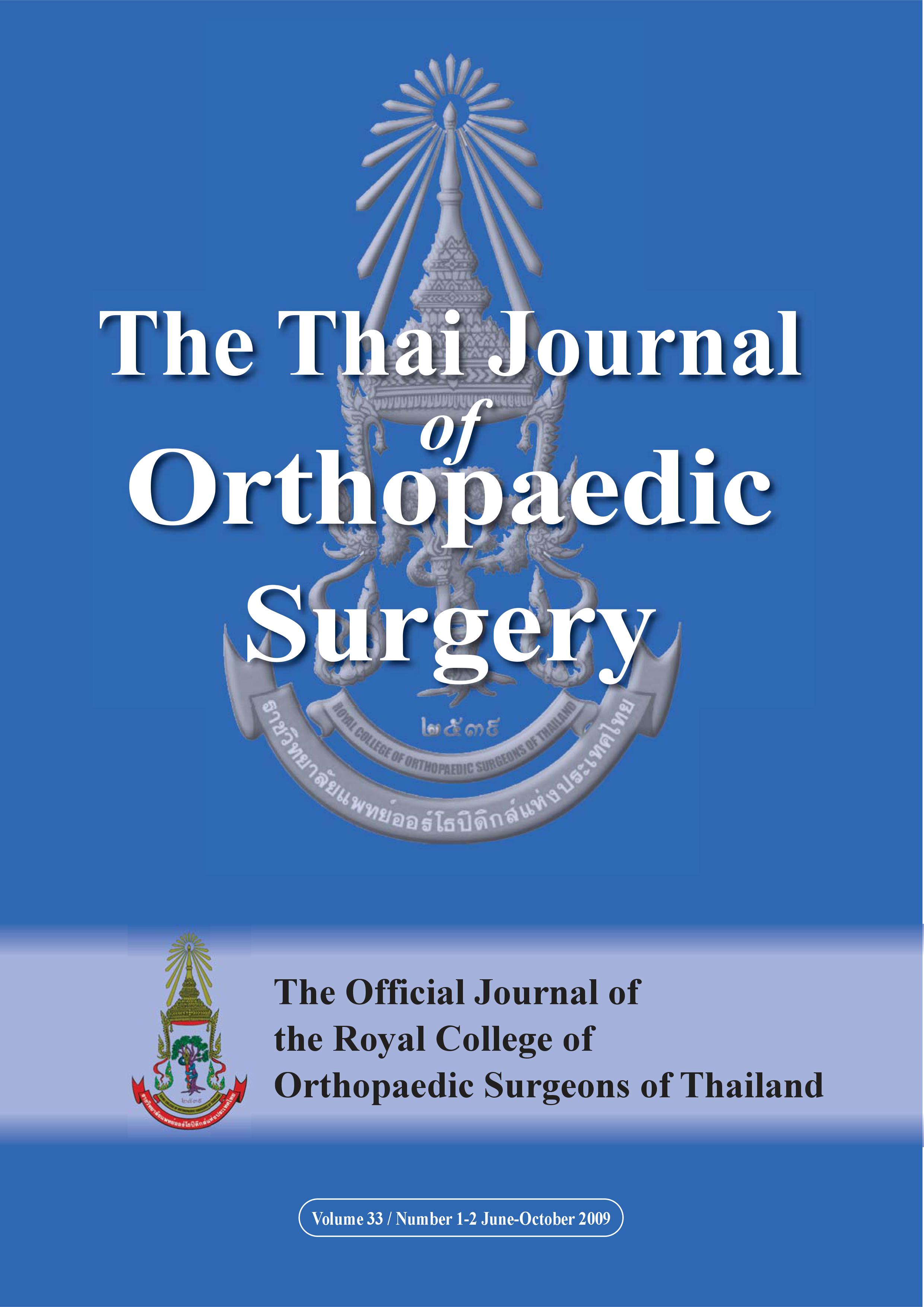Using Digital Wound Photography to Improve Communication among Orthopaedic Health Care Professionals in Orthopeadic Patients
Main Article Content
Abstract
Objective: To evaluate the usefulness and reliability of digital photographs in communicating wound assessment.
Methods: 50 open wounds from Orthopaedic inpatients.were studied. First, one senior nurse evaluated the wound and took a picture with a digital camera before verbally communicating the wound’s characteristics to other nurses, Orthopaedic residents, and staff. All assessors then evaluated the digital photograph of the same wound before assessing the wound of the patient. All assessors rated the usefulness of the digital photograph compared with verbal communication.
The second part of this study involved the reliability test. Fifty previous digital photographs were tested twice, one month apart, for inter-rater and intra-rater agreement among nurses, residents, and staff.
Results: Most assessors agreed that communication via digital photograph was significantly better than verbal communication. Mean acceptability scores of digital photographs were significantly higher than verbal communication for clarity, details, decision guidance, and satisfaction. However, the reliability of wound care assessment was still at a fair of level of agreement among all assessors.
Conclusion: Digital photographs are useful for communication among members of a health care team.
Article Details
References
2. Cohen M, Gildi M, Mayo A, Shafir R. The gra- nulometer: a pocket scale for the assessment of wound healing. Ann Plast Surg. 1998; 40(6): 641-5.
3. Hansen GL, Sparrow EM, Kokate JY, Leland KJ, Iaizzo PA. Wound status evaluation using color image processing. IEE Trans Med Imaging. 1997; 16(1): 78-86.
4. Hayes S, Dodds S. Digital photography in wound care. Nursing Times. 2003; 99(42): 48-9.
5. Andres BM, Khanna AJ, Wenz JF Sr, Faust AF, Frassica FJ. A comparison of digital cameras: features essential for the orthopaedic surgeon. Clin Orthop Relat Res. 2004; 421: 10-6.
6. Murphy RX Jr, Bain MA, Wasser TE, Wilson E, Okunski WJ. The reliability of digital imaging in remote assessment of wounds: defining a standard. Ann Plast Surg. 2006; 56(4): 431-6.
7. Jones OC, Wilson D I, Andrews S. The reliability of digital images when used to assess burn wounds. Journal of telemedicine and telecare. 2003; 9(Suppl 1): 22-4.
8. Rajbhandari SM, Harris ND, Sutton M, Lockett C, Eaton S, Gadour M, et al. Digital imaging: an accurate and easy method of measuring foot ulcers. Diabet Med. 1999; 16(4): 339-42.
9. Roth AC, Reid JC, Puckett CL, Concannon MJ. Digital images in the diagnosis of wound healing problems. Plastic Reconstr Surg. 1999; 103(2): 483-6.
10. Russell L, Reynolds TM. Using image analysis to determine cause, severity, status and healing prognosis in wound management. J Wound Care. 2005; 14(9): 433-6.
11. Landis JR, Koch GC. The measurement of observer agreement for categorical data. Biometrics. 1977; 33(1): 159-74.
12. Van LB, Sicotte KM, Lassiter RR, Jablonski KA, Crean DA, Jeng JC, et al. Digital photography: enhancing communication between burn therapists and nurses. J Burn Care & Rehabil. 2004; 25(1): 54-60.
13. Jones SM, Banwell PE, Shakespeare PG. Telemedicine in wound healing. Int Wound J. 2004; 1(4): 225-30.
14. Ong CA. Telemedicine and wound care. Stud Health Technol Inform. 2008; 131: 211-5.
15. Rees RS, Bashshur N. The effects of telewound management on use of service and financial outcomes. Telemed J E Health. 2007; 13(6): 663-74.
16. Hofmann-Wellenhof R, Salmhofer W, Binder B, Okcu A, Kerl H, Soyer HP. Feasibility and acceptance of telemedicine for wound care in patients with chronic leg ulcers. J Telemed Telecare. 2006; 12(Suppl 1): 15-7.
17. Wirthlin DJ, Buradagunta S, Edwards RA, Brewster DC, Cambria RP, Gertler JP, et al. Telemedicine in vascular surgery: Feasibility of digital imaging for remote management of wounds. J Vascular Surg. 1998; 27(6): 1089-98.
18. Tangtrakulwanich B, Kwunpiroj W, Chongsu- vivatwong V, Geater AF, Kiatsiriroj N. Teleconsultation with digital camera images is useful for fracture care. Clin Orthop. 2006; 449: 308-12.
19. Chandhanayingyong C, Tangtrakulwanich B, Kiriratnikom T. Teleconsultation for emergency orthopaedic patients using the multimedia messaging service via mobile phones. J Telemed Telecare. 2007; 13(4): 193-6.
20. Armstrong MJ, Booth C. Electronic health records in ambulatory care. N Engl J Med. 2008; 359(17): 1848-9.
21. DesRoches CM, Campbell EG, Rao SR, Donelan K, Ferris TG, Jha A, et al. Electronic health records in ambulatory care--a national survey of physicians. N Engl J Med. 2008; 359(1): 50-60.
22. Windsor JS, Rodway GW, Middleton PM, McCarthy S. Digital photography. Postgrad Med J. 2006; 82(972): 688-92.
23. Galdino GM, Vogel JE, Vander Kolk CA. Standardizng digital photography: it’s not all in the eye of the beholder. Plast Reconstr Surg. 1999; 103: 483-6.


